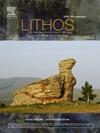Xonotlite and pectolite in rodingites from the Samail ophiolite: Markers of reducing conditions and element transfer during peridotite-gabbro interaction
IF 2.5
2区 地球科学
Q2 GEOCHEMISTRY & GEOPHYSICS
引用次数: 0
Abstract
The Oman Drilling Project cored Holes BA1B, BA3A and BA4A into serpentinized peridotites in Wadi Lawayni of the Samail ophiolite, Oman. These mantle peridotites are crosscut by numerous gabbro, olivine gabbro and clinopyroxenite dikes that are altered to calc-silicate assemblages (hydrogarnet, diopside, xonotlite, vesuvianite and pectolite), chlorite, and phlogopite. These mineralogical assemblages are typical of rodingites. Xonotlite [Ca6Si6O17(OH)2] and pectolite [NaCa2Si3O8(OH)] forming as fibrous or acicular/radial crystals in milk-white vein-like are common in these holes. In contrast, only a few occurrences of these minerals have been reported worldwide. Bulk rock analyses indicate two types of altered dikes: chlorite-bearing dikes displaying enrichments in Mg, Fe, Mn, Ti, Cr, Ni and volatiles as well as loss of Na compared to lower crustal gabbros; and rodingitized dikes with enrichments in Ca and Na during alteration. Mass gains in chlorite-bearing dikes are consistent with intense mass transfer from peridotite to gabbroic dikes. These results are consistent with thermodynamic modelling showing a strong control of the peridotite-gabbro ratio on the mineralogy of the altered gabbro: wollastonite, pectolite, and vesuvianite present here are predicted to form in peridotite-dominated systems, whereas prehnite, epidote and pumpellyite not reported in the studied boreholes are predicted to form in gabbro-dominated systems. Fluid inclusions containing H2 and CH4 are observed in both primary orthopyroxene and pectolite. They indicate the presence of a carbon-rich reduced fluid during rodingitization. The xonotlite stability field calculated with thermodynamic modelling is indeed limited by carbonate formation as oxygen fugacity increases. The rodingites from Oman display numerous markers of strong fluid/rock interactions, including enrichment in mobile elements such as Na, K and Li, typically associated with seawater interaction and hydrothermal fluid transport. The presence of xonotlite, pectolite and phlogopite is consistent with the addition of external elements during rodingitization since the extent of the calculated stability fields of these minerals increases when adding Ca, Na and K to the system. High δ44/40Ca values in chlorite-bearing dikes (1.65 ± 0.09 ‰ to 1.91 ± 0.09 ‰), rodingitized dikes (0.28 ± 0.09 ‰ to 1.25 ± 0.02 ‰) and serpentinized harzburgites (1.04 ± 0.05 ‰ to 1.64 ± 0.06 ‰) reveals mineral-fluid fractionation of Ca isotopes and/or interaction of seawater with gabbro-peridotite samples.
Samail蛇绿岩中绿橄榄岩和榴辉石:橄榄岩-辉长岩相互作用中还原条件和元素转移的标志
阿曼钻井项目在阿曼Samail蛇绿岩Wadi Lawayni的蛇纹岩中取心BA1B、BA3A和BA4A孔。这些地幔橄榄岩被大量辉长岩、橄榄石辉长岩和斜辉长岩岩脉横切,这些岩脉蚀变为钙硅酸盐组合(水榴石、透辉石、软橄榄岩、维苏岩和榴辉岩)、绿泥石和绿云母。这些矿物组合是典型的榴辉岩。钙辉石[Ca6Si6O17(OH)2]和胸石[NaCa2Si3O8(OH)]在这些孔洞中形成纤维状或针状/放射状晶体,呈乳白色脉状。相比之下,这些矿物在世界范围内的发现却很少。整体岩石分析表明,蚀变岩脉有两种类型:含绿泥石岩脉与下地壳辉长岩相比,Mg、Fe、Mn、Ti、Cr、Ni和挥发物富集,Na损失较大;蚀变过程中富Ca、Na的岩脉被改造。含绿泥石岩脉的质量增加与橄榄岩向辉长岩岩脉的强烈质量传递一致。这些结果与热力学模型一致,表明橄榄岩-辉长岩比对蚀变辉长岩的矿物学有很强的控制作用:硅灰石、榴辉石和维苏岩预计在橄榄岩为主的体系中形成,而在研究钻孔中未报告的前辉长岩、绿帘石和泵长岩预计在辉长岩为主的体系中形成。原生正辉石和榴辉石中均可见含H2和CH4的流体包裹体。它们表明在石化过程中存在富碳还原流体。随着氧逸度的增加,用热力学模型计算的硬硅橄榄岩稳定性场确实受到碳酸盐地层的限制。阿曼罗纹岩显示出许多强流体/岩石相互作用的标志,包括Na、K和Li等可移动元素的富集,这些元素通常与海水相互作用和热液流体运输有关。硅辉石、硅辉石和绿云母的存在与岩化过程中外部元素的加入是一致的,在体系中加入Ca、Na和K时,这些矿物的计算稳定性场的范围增大。含绿泥石岩脉(1.65±0.09‰~ 1.91±0.09‰)、绿泥岩岩脉(0.28±0.09‰~ 1.25±0.02‰)、蛇纹岩岩脉(1.04±0.05‰~ 1.64±0.06‰)的高δ44/40Ca值显示了Ca同位素的矿液分馏和/或海水与辉长岩-橄榄岩样品的相互作用。
本文章由计算机程序翻译,如有差异,请以英文原文为准。
求助全文
约1分钟内获得全文
求助全文
来源期刊

Lithos
地学-地球化学与地球物理
CiteScore
6.80
自引率
11.40%
发文量
286
审稿时长
3.5 months
期刊介绍:
Lithos publishes original research papers on the petrology, geochemistry and petrogenesis of igneous and metamorphic rocks. Papers on mineralogy/mineral physics related to petrology and petrogenetic problems are also welcomed.
 求助内容:
求助内容: 应助结果提醒方式:
应助结果提醒方式:


